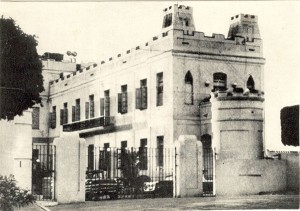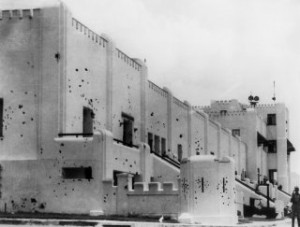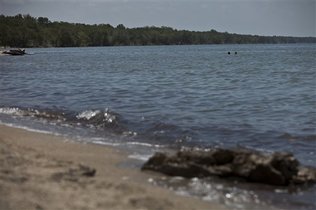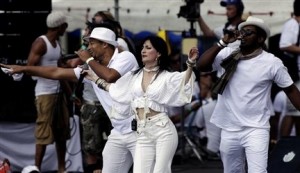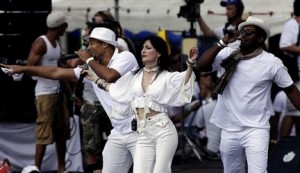EL ATAQUE AL MONCADA. MITOLOGÍA DE CASTRO.
Los fidelistas no lograron tomar el cuartel Moncada y aquello se convirtió en una carnicería. No podía resultar otra cosa de aquel plan descabellado que incluía barbaridades criminales tales como la toma de un vecino hospital civil.
Antonio Guiteras se adelantó casi 20 años a Fidel Castro en la idea de intentar tomar un cuartel del ejército. A diferencia de Castro, Guiteras lo consiguió.
Con un puñado de hombres armados con escopetas de caza, Guiteras tomó no solo el cuartel de San Luis, sino el poblado completo y luego logró replegarse con su grupo hacia la Sierra Maestra, donde permaneció alzado hasta casi un mes después de la caída del régimen de Gerardo Machado. No bajó de las lomas hasta que en septiembre de 1933 el presidente Ramón Grau lo nombró primero gobernador de la provincia de Oriente, y luego, Secretario de Gobernación, lo que equivalía a ser el segundo de su gobierno.
En honor a la verdad, el plan de Guiteras en 1932 era mucho más modesto que el de Fidel Castro en 1953, cuando atacó el cuartel Moncada. El de San Luis, era un cuartelito defendido por poco más de una decena de soldados mientras que el Moncada era la segunda fortaleza militar de Cuba, con una guarnición de mil hombres.
Siempre me he preguntado qué hubiera pasado en el caso -harto improbable por demás- de que Fidel Castro hubiera conseguido tomar el cuartel Moncada.
Si además hubiese logrado tomar los cuarteles de la Policía Nacional y de la Marina de Guerra, ¿no se habría convertido Santiago de Cuba en una ratonera para los asaltantes? Si los fidelistas hubiesen tomado también el cuartel de Bayamo, ¿habrían podido contener luego a los refuerzos del ejército que acudirían sobre Santiago? Luego de perdida la ciudad, ¿Hubiesen podido los rebeldes escapar de los bombardeos de la aviación y refugiarse en la Sierra Maestra para iniciar la guerra de guerrillas?
El caso es que los fidelistas no lograron tomar el cuartel Moncada y aquello se convirtió en una carnicería. No podía resultar otra cosa de aquel plan descabellado que incluía barbaridades criminales tales como la toma de un vecino hospital civil.
Solo que la especialidad de Fidel Castro, además de los planes descabellados, era convertir los reveses, por grandes que fuesen, en victorias, o al menos, en algo que lo pareciera.
Da grima, por enajenante, que una carnicería que dio inicio a una pesadilla que parece interminable se haya convertido en fecha de fiesta nacional, tres días feriados y carnavales incluidos: la festividad más larga del muy extenso aburrimiento castrista.
El ataque al cuartel Moncada es el ejemplo clásico de disparate que un movimiento armado nunca debe cometer si aspira ser exitoso. Si no estuviese desde hace años en el infierno, le podrían preguntar al respecto al terrorista argentino Enrique Gorriarán Merlo, el cabecilla del Ejército Revolucionario del Pueblo, que se escachó sangrientamente dos veces por querer reeditar el Moncada, primero en 1976, en Monte Chingolo, y luego en el regimiento militar de La Tablada, en enero de 1989.
No obstante, el fallido ataque al cuartel santiaguero, el desembarco –o más bien el naufragio- del yate Granma, y la desastrosa campaña boliviana de Che Guevara, siguen siendo hoy los pasajes más ensalzados de la persistente mitología castrista, que parece inmune a toda lógica.
PrimaveraDigital/LuisCino, La Habana//InternetPhotos/www.thecubanhistory.com
The Cuban History, Hollywood.
Arnoldo Varona, Editor.
Malecón de la Habana. Cuba en Fotos.

MONCADA BARRACKS ATTACK. CASTRO’S MYTHOLOGY.
The fidelistas failed to take the Moncada Barracks and that became a bloodbath. It could not be otherwise than that crazy plan that included criminal atrocities such as the taking of a neighboring civil hospital.
Antonio Guiteras came forward almost 20 years to Fidel Castro on the idea of trying to make an army barracks. Unlike Castro, Guiteras succeeded.
With a handful of men armed with shotguns men Guiteras took not only the headquarters of San Luis, but the entire village and then managed to retreat with your group to the Sierra Maestra, where he remained flat until nearly a month after the fall of the regime Gerardo Machado. It came down from the hills until September 1933 President Ramón Grau appointed first governor of the province of Oriente, and then Secretary of the Interior, which was equivalent to being second to his government.
In all honesty, Guiteras plan in 1932 was much more modest than that of Fidel Castro in 1953, when he attacked the Moncada barracks. The St. Louis was a guardhouse defended by little more than a dozen soldiers while the Moncada military fortress was the second of Cuba, with a garrison of a thousand men.
I’ve always wondered what would have happened in the case-by others-highly unlikely that Fidel Castro had managed to take the Moncada barracks.
If you also have managed to take the headquarters of the National Police and the Navy, would not have become Santiago de Cuba in a trap for thieves? If fidelistas had also taken the barracks in Bayamo, then would they have been able to contain that army reinforcements would come about Santiago? After the city lost, Would they have been able to escape the rebels shelling aviation and take refuge in the Sierra Maestra to start guerrilla warfare?
Anyway, take the fidelistas failed Moncada and that became a bloodbath. It could not be otherwise than that crazy plan that included criminal atrocities such as the taking of a neighboring civil hospital.
Only the specialty of Fidel Castro, in addition to the harebrained schemes was turn setbacks, however great they were, in wins, or at least something that seems.
Da grime, by alienating that a carnage began a seemingly endless nightmare has become a national holiday date, three days including holidays and carnivals: the longest holiday of extensive Castro boredom.
The Moncada attack is the classic example of nonsense that an armed movement should never make if it hopes to succeed. If it were not for years in hell, you could ask about the Argentine terrorist Enrique Gorriarán Merlo, the leader of the People’s Revolutionary Army, which was bloodily escacho twice want to reissue the Moncada, first in 1976 in Monte Sparrow, and then the La Tablada military regiment in January 1989.
However, the failed attack Santiago headquarters, the landing-or rather the wreck-yacht Granma, and the disastrous Bolivian campaign of Che Guevara, remain today the most exalted passages Castro persistent mythology that seems immune to all logic.
PrimaveraDigital / LuisCino, LA Habana / InternetPhotos / www.thecubanhistory.com
The Cuban History, Hollywood.
Arnoldo Varona, Editor





